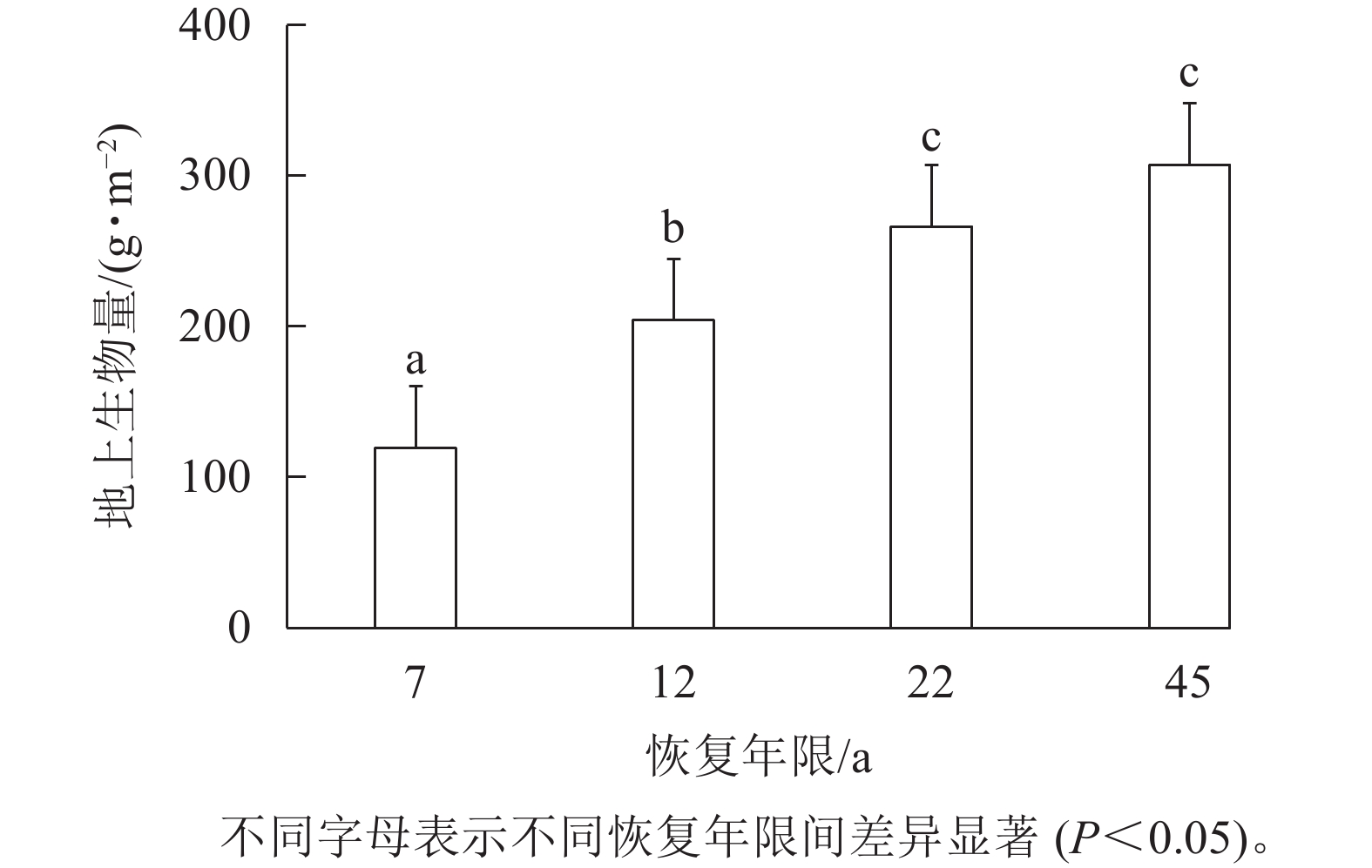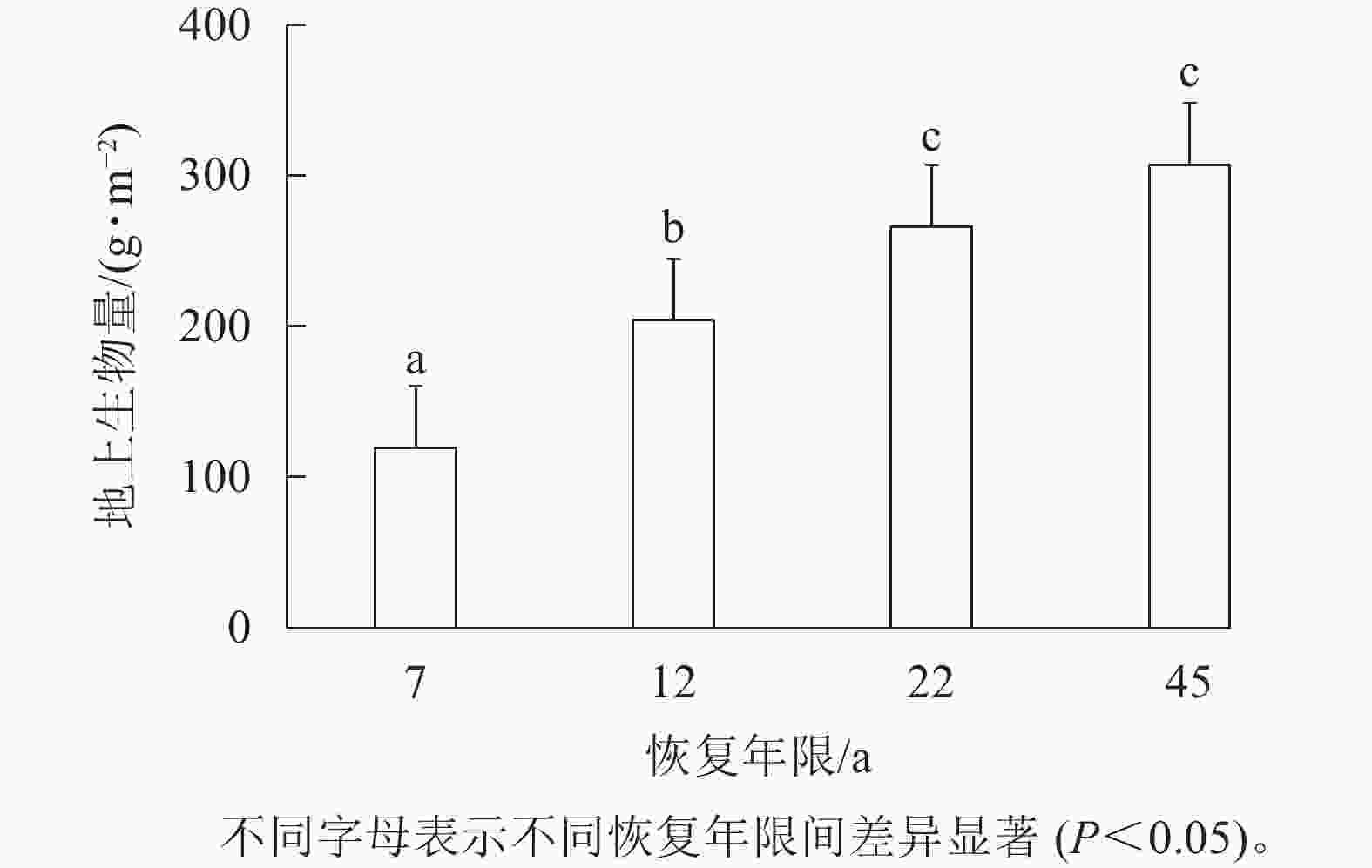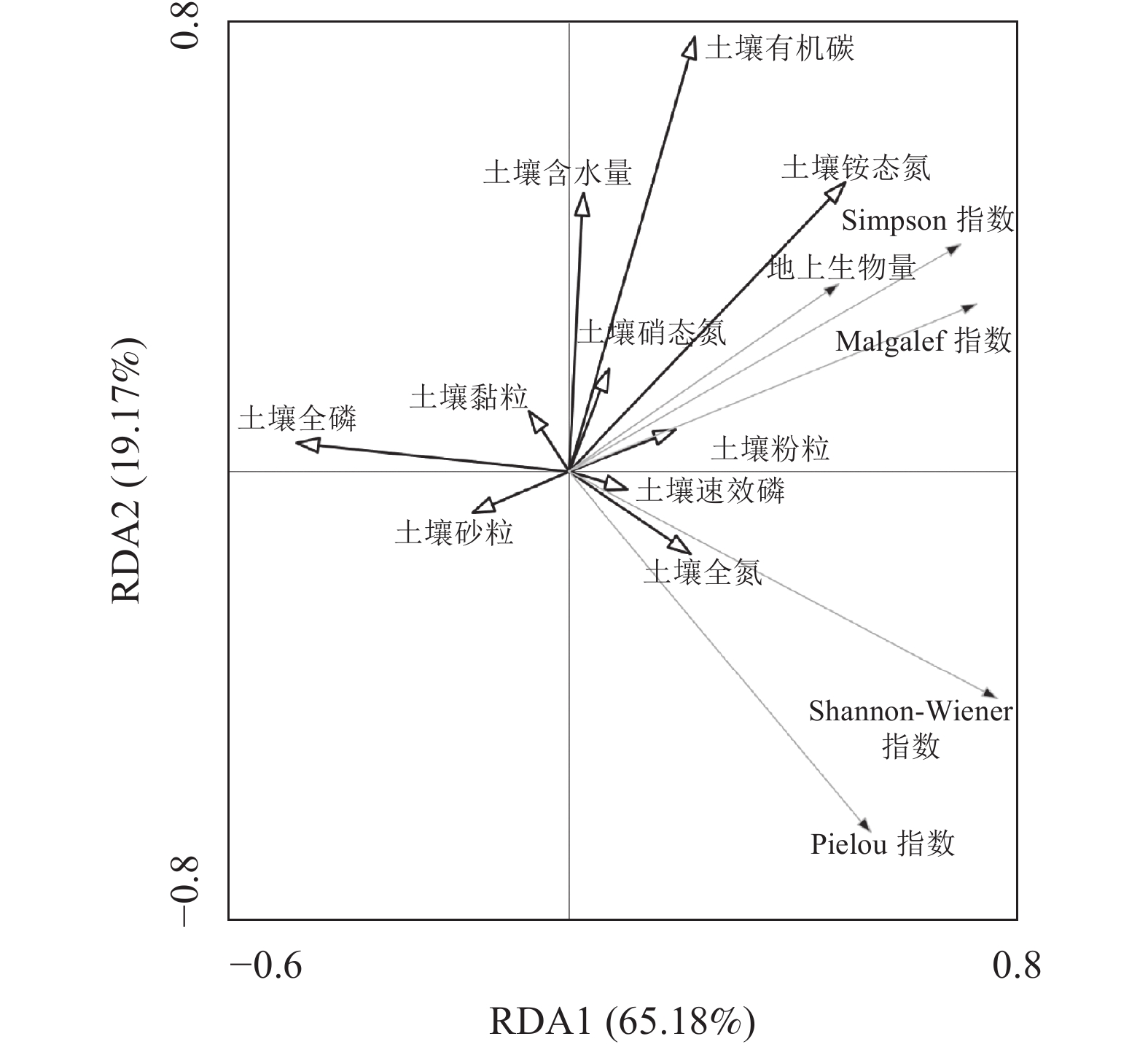-
森林生态系统是陆地生态系统的重要组成部分,无论是天然林还是人工林生态系统都具有丰富的生物多样性[1−2]。一直以来,由于受到全球气候变化和人类活动的双重影响,森林生态系统的生物多样性持续下降,尤其人工林生态系统的生物多样性对其两者的响应更加敏感,部分生态功能随之退化[3−4]。近年来,大量人工林的出现使得黄土高原地区的植被变化尤为剧烈[5]。由于刺槐Robinia pseudoacacia具有抗旱耐瘠、生长迅速等特点,被选为主要的造林树种之一,因此在该地区被大面积种植[6]。目前,针对人工林生态系统功能及其生物多样性的研究还处在蓬勃发展时期[7−10]。前人针对刺槐林的相关研究集中在林上冠层和亚冠层,对地上生物量、物种多样性及其影响下的土壤水分、土壤固碳等[11−13]特征的研究也较多,但缺乏对刺槐林林下草本层物种多样性、养分循环和水土保持等[14−16]方面的研究。林下草本层作为森林生态系统的重要组成部分,其丰富的生物多样性不仅有助于维持生态系统的稳定性,还能优化生态系统功能,缓解气候变化,改善局部小气候[17]。此外,林下草本层也有助于土壤品质和肥力的提高,促进土壤养分循环[18]。虽然林下草本层的生态位相对较小,其生长、发育和丰富程度也易受外界环境的影响,但它在生态恢复、土壤固碳和保持水土等方面仍然发挥着不可替代的作用[19−20]。林下草本层的物种多样性受诸多环境因素的影响,且这些因素内部关系复杂。一些学者对不同植被类型、不同密度等林下草本层物种多样性及其影响因子进行了研究[21−23],而对黄土高原地区不同恢复年限林下草本层物种多样性及其影响因素等研究相对缺乏。在此背景下,明确黄土高原地区广泛分布的刺槐林林下草本层物种多样性在不同生长阶段的变化特征及其主要影响因素意义重大。因此,本研究以陕西省子长市南部不同恢复年限的刺槐林为研究对象,分析各阶段刺槐林林下草本层物种多样性特征及其主要影响因素,以期为正确评价该地区人工造林生态效应以及可持续植被恢复管理实践提供依据。
-
陕西省子长市(36°59′30″~37°30′00″N,109°11′58″~110°01′22″E)属暖温带半干旱大陆性季风气候,地势西北高东南低,海拔为930.0~1 562.0 m,是典型的黄土丘陵沟壑区,年均气温为8.2 ℃,年均降水量为450.0 mm。当地土壤以黄绵土为主,土壤结构较差,易受冬、春季风力侵蚀和夏、秋季水力侵蚀。该地区是退耕还林的核心区域,主要引进树种有刺槐、侧柏Platycladus orientalis、沙棘Hippophae rhamnoides、柠条Caragana korshinskii、油松Pinus tabuliformis等。刺槐是该区分布最广的造林树种。
-
样地选择、野外调查和土壤样品采集均于2022年8月在子长市南部进行。选择靠城区4个恢复年限(7、12、22、45 a)的人工刺槐林为研究对象,该地造林之前均为退耕农地(主要种植谷子Setaria italica、糜子Panicum miliaceum和土豆Solanum tuberosum等农作物)。不同恢复年限的每块样地面积为20 m×20 m,3个重复,同时采用对角线法在每块样地中选取5个1 m×1 m的小样方,观察样方中草本层植物的分布情况,记录每块样地的生长年限、种植密度,对样方中的草本层进行调查并记录物种名称、盖度、数量和频度等信息。记录完成之后,将每块样方中的草本层植物齐根剪下,装进信封,带回实验室烘干称量,记录每块样地草本生物量。在每个样方内用100 cm3的环刀(测定土壤容重)和铝盒分别取0~20 cm土层的土样,3个重复。除去根系和杂物,将铝盒中土样混合均匀后分为2份,一部分用于测定土壤水分(烘干法),另一部分用于测定土壤相关指标[24]。土壤有机碳采用重铬酸钾外加热法测定,全氮采用半微量凯氏法测定,全磷采用HClO4-H2SO4消煮法测定,硝态氮采用紫外分光光度法测定,铵态氮采用靛酚蓝比色法测定,速效磷采用碳酸氢钠法测定,土壤粒度采用激光粒度仪法测定。
-
通过Margalef指数、Simpson指数、Shannon-Wienner指数、Pielou指数以及重要值分析不同恢复年限刺槐林林下草本层的物种多样性。多样性指数及重要值的具体计算公式参考文献[15, 21]。
-
采用SPSS 23.0进行数据处理,采用单因素方差分析(one-way ANOVA)对比不同恢复年限刺槐林林下草本层物种多样性之间的差异,并通过最小显著极差法(LSD)进行多重比较,显著性水平为0.05;采用Canoco 5.0进行冗余分析(RDA),研究草本层物种多样性指标、地上生物量与环境因子之间的相互关系。
-
不同恢复年限刺槐林林下草本植物共有55种,分属18科,物种相对较为丰富(表1)。主要为菊科Compositae (25.8%)、禾本科Gramineae (18.4%)以及豆科Leguminosae (9.2%)植物,其他如莎草科Cyperaceae、蔷薇科Rosaceae、葡萄科Vitaceae、堇菜科Violaceae、车前科Plantaginaceae、唇形科Lamiaceae、旋花科Convolvulaceae、远志科Polygalaceae、紫草科Boraginaceae、萝藦科Asclepiadaceae等均为单属单种。
物种 所属科 不同恢复年限物种重要值 物种 所属科 不同恢复年限物种重要值 7 a 12 a 22 a 45 a 7 a 12 a 22 a 45 a 茵陈蒿Artemisia capillaris 菊科 3.41 6.41 8.14 地梢瓜Cynanchum thesioides 萝藦科 − 0.60 3.60 1.94 青蒿Artemisia caruifolia 菊科 20.51 17.79 1.20 2.84 西山委陵菜Potentilla sischanensis 蔷薇科 − 0.87 − − 北艾Artemisia vulgaris 菊科 24.19 15.19 25.97 47.60 小叶地锦Euphorbia heyneana 葡萄科 − − 2.34 2.40 紫苏Perilla frutescens 唇形科 0.93 − − − 大果琉璃草Cynoglossum divaricatum 紫草科 − − 1.27 − 苦荬菜Ixeris polycephala 菊科 2.69 1.87 1.20 1.80 黄花委陵菜Potentilla chrysantha 蔷薇科 − − 0.60 − 糙隐子草Cleistogenes squarrosa 禾本科 1.77 − − − 二裂委陵菜Potentilla bifurca 蔷薇科 − − 4.80 − 黄花蒿Artemisia annua 菊科 0.60 − − 9.88 地丁草Corydalis bungeana 堇菜科 − − 2.20 1.27 狗娃花Heteropappus hispidus 菊科 3.27 − 2.47 1.27 猪毛蒿Artemisia scoparia 菊科 − − 2.73 − 硬质早熟禾Poa sphondylodes 禾本科 3.27 2.68 7.08 2.34 刺儿菜Cirsium setosum 菊科 − − 0.67 − 野菊Dendranthema indicum 菊科 1.33 1.00 − 2.08 杠柳Periploca sepium 夹竹桃科 − − 2.13 − 铁杆蒿Artemisia gmelinii 菊科 1.13 22.12 8.94 1.80 小花鬼针草Bidens parviflora 菊科 − − 0.53 − 冰草Agropyron cristatum 禾本科 8.61 − − 1.87 阿尔泰堇菜Volai altaica 堇菜科 − − 0.53 − 角蒿Incarvillea sinensis 菊科 0.73 − − 0.67 委陵菜Potentilla chinensis 蔷薇科 − − − 0.53 甘草Glycyrrhiza uralensis 豆科 0.60 − − − 鹅观草Roegneria kamoji 禾本科 − − 0.67 − 腺毛阴行草Siphonostegia laeta 列当科 2.00 − − 1.20 菊叶香藜Chenopodium foetidum 苋科 − − − 1.87 狗尾草Setaria viridis 禾本科 1.34 − 2.13 2.68 堇菜Viola verecunda 堇菜科 − − − 5.67 箭叶旋花Convolvulus arvensis 旋花科 2.87 5.48 − 0.67 蒲公英Taraxacum mongolicum 菊科 − − − 2.54 小蒜Allium macrostemon 百合科 0.53 − − 0.60 羊草Leymus chinensis 禾本科 − − − 0.94 野豌豆Vicia sepium 豆科 1.80 − − − 羊胡子草Carex rigescens 莎草科 − − − 0.40 苣荬菜Sonchus wightianus 菊科 0.60 − − − 戟叶火绒草Leontopodium dedekensii 菊科 − − − 1.40 黄花棘豆Oxytropis ochrocephala 豆科 0.33 − 2.60 − 远志Polygala tenuifolia 远志科 − − − − 草木犀Melilotus officinalis 豆科 1.40 − − − 细叶薹草Carex duriusata 莎草科 − − − − 车前草Plantago depressa 车前科 0.47 − − 5.21 异叶败酱Patrinia heterophylla 忍冬科 − − − − 羊茅Festuca ovina 禾本科 − 13.21 25.51 13.57 甘青针茅Stipa przewalskyi 禾本科 − − − − 芦苇Phragmites australis 禾本科 − 0.67 0.53 − 针茅Stipa capillata 禾本科 − − − − 兴安胡枝子Lespedeza davurica 豆科 − 0.67 3.60 1.27 地椒Thymus quinquecostatus 唇形科 − − − − 大披针薹草Carex lanceolata 莎草科 − 13.70 − − 百里香Thymus mongolicus 唇形科 − − − − 猪毛菜Salsola collina 苋科 − 0.53 − 1.60 说明:−代表没有出现。菊科Compositae;唇形科Lamiaceae;禾本科Gramineae;豆科Leguminosae;列当科Orobanchaceae;旋花科Convolvulaceae;百合科Liliaceae;车前科Plantaginaceae;莎草科Cyperaceae;苋科Amaranthaceae;萝藦科Asclepiadaceae;蔷薇科 Rosaceae;葡萄科Vitaceae;紫草科Boraginaceae;堇菜科Violaceae;夹竹桃科Apocynaceae;远志科Polygalaceae;忍冬科Caprifoliaceae。 Table 1. Importance values of dominant species in the understory herb layer of R. pseudoacacia forests in different years
不同恢复年限刺槐林林下草本层物种组成有较大差异。其中恢复年限为7 a的刺槐林共有23个草本物种,以青蒿Artemisia caruifolia和北艾A. vulgaris为优势物种,伴生物种主要有茵陈蒿A. capillaris和冰草Agropyron cristatum;恢复年限为12 a的刺槐林共有14个草本物种,以铁杆蒿Artemisia gmelinii和青蒿为优势物种,伴生物种主要有北艾和大披针薹草Carex lanceolata;恢复年限为22 a的刺槐林共有24个草本物种,以北艾和羊茅Festuca ovina为优势物种,伴生物种主要有铁杆蒿和硬质早熟禾Poa sphondylodes;恢复年限为45 a的刺槐林共有29个草本物种,以北艾和羊茅为优势物种,伴生物种主要有黄花蒿A. annua和茵陈蒿。
-
如表2所示:不同恢复年限刺槐林林下草本层物种多样性存在差异。除恢复年限为22和45 a刺槐林林下草本层的Margalef指数差异不显著外(P>0.05),其他恢复年限的Margalef指数则随着恢复年限的增加而逐步增加;不同恢复年限刺槐林林下草本层的Simpson指数与Margalef指数表现出相似的变化趋势。除恢复年限为22和45 a刺槐林林下草本层之间的Simpson指数差异不显著外(P>0.05),其他恢复年限的Simpson指数则随着恢复年限的增加而增加;不同恢复年限刺槐林草本层的Shannon-Wiener指数整体上随着恢复年限的增加而增加,但恢复年限为12和22 a之间的Shannon-Wiener指数差异不显著(P>0.05);刺槐林林下草本层的Pielou指数在恢复年限为7、12 a有所增加,在12 a之后呈相对稳定的趋势。
恢复年限/a Margalef指数 Simpson指数 Shannon-Wiener指数 Pielou指数 7 0.44±0.09 c 2.15±0.53 c 0.16±0.07 c 0.07±0.03 b 12 1.40±0.09 b 6.79±0.33 b 0.53±0.04 b 0.26±0.02 a 22 2.12±0.12 a 11.20±0.59 a 0.59±0.02 b 0.24±0.01 a 45 2.27±0.13 a 12.54±0.44 a 0.79±0.07 a 0.30±0.02 a 说明:数据为平均值±标准差;同列数据后不同字母表示同一指标不同恢复年限间差异显著(P<0.05)。 Table 2. Species diversity index in the understory herb layer of R. pseudoacacia forests in different years
-
从图1可以看出:刺槐林林下草本层的地上生物量随着恢复年限的增加而逐步增加。除恢复年限为22与45 a之间的草本生物量没有显著性差异外,其余恢复年限之间均有显著性差异(P<0.05)。刺槐林的地上生物量从恢复年限7 a (119.33 g·m−2)到12 a (204.00 g·m−2)、22 a (266.33 g·m−2)、45 a (307.33 g·m−2),分别增加了1.71、2.23和2.58倍。这表明地上生物量随着刺槐林恢复年限的增加持续增加。
-
选取10个土壤因子作为环境变量,草本物种多样性4个指标和地上生物量作为响应变量进行冗余分析。由图2可看出:10个环境变量能综合解释96.23%的林下草本物种多样性及生物量变化格局。第1轴解释率为65.18%,第2轴解释率为19.17%。Margalef指数、Simpson指数、地上生物量与土壤铵态氮、土壤有机碳、土壤水分呈正相关,与土壤全磷为负相关,说明它们是影响这2个指标的影响因素。Shannon-Wiener指数、Pielou指数与土壤全氮、土壤铵态氮、土壤粉粒为正相关,与土壤水分、土壤有机碳和土壤全磷为负相关,说明它们是影响这2个指标的影响因素。刺槐林林下草本层物种多样性指数与地上生物量整体呈正相关关系。
-
在全球变暖背景下,林下草本层的多样性特征对整个森林生态系统的多样性和稳定性具有重要指示意义。研究黄土高原地区单一树种人工林林下草本层物种多样性,对恢复区域人工林生态系统的结构和功能,维持区域人工林生态系统的稳定性和可持续性意义重大[2, 7]。植物多样性指数的大小反映了不同群落之间物种丰富度和物种相对丰度的差异。多样性指数越大,说明该群落内物种的丰富度和相对丰度分布较为均衡,反之亦然[9, 19]。植物多样性主要是由群落内部物种间的关系和外部环境条件决定的,植物多样性差异在一定程度上也能够反映外部环境条件的变化[2, 9]。本研究发现:刺槐林林下优势种主要为菊科、禾本科和豆科,整体物种组成也显示出多数优势种属于少数科,而少数弱势种属于多数科的特征,这与相关的研究结果[15−16]基本一致,符合西北地区植物区系特征[25]。然而,与子长市北部研究结果[15]不同的是,相对湿润的南部区域拥有更多的林下草本物种类型,且在恢复年限为45 a刺槐林下仍然发现较多的物种类型。主要是因为南部相对湿润,虽然刺槐林消耗了大量深层土壤水分,但表层土壤会随其生长演替表现出更好的土壤水分涵养能力。因此,恢复年限为45 a的刺槐林下发现较多的草本种类数量主要是湿润的土壤表面萌生了更多的弱势植物所致[10]。而优势种仍然是具有极强适应能力的蒿属Artemisia植物,比如北艾、铁杆蒿、青蒿等。前2种蒿属均为多年生植物,在刺槐林的次生演替阶段大都能发现其踪迹,主要是因为随着演替的进行,1年生植物逐渐失去优势成为伴生种,而具有营养枝的多年生植物占比增加,逐渐演变为优势种。表明这些物种在长期的气候变化过程中很好地适应了本地区的水热气等条件,并建立优势[25−26]。因此,建议在黄土高原地区应加强对蒿属等优势种展开生态功能等方面的研究,从蒿属植物的基础研究入手,深入开发和应用这些物种在该地区的潜在生态价值,为黄土高原地区生态建设提供参考。
生物多样性和生产力之间的关系在不同生态系统下的表现截然不同[27]。有研究认为:生物多样性与生产力呈正相关,而另一些研究却恰好相反,甚至得出不相关的结论[27−28]。本研究表明:生物多样性和生产力呈正相关,这与王敏等[29]的研究结果较为一致,但与南国卫等[15]在子长市北部的研究结果不一致。主要是因为林下草本层物种多样性与生物量的关系在不同生态系统或者相同生态系统下的不同演替阶段是不断变化的,这主要取决于林下环境(光照、温度、土壤水分、养分等)的变化情况[2, 4]。本研究区域不同恢复阶段刺槐林林下拥有不同的环境。另外,由于刺槐的高耗水性,使得林下草本层的物种多样性和生物量关系的变化更加复杂[10−12]。本研究表明:土壤铵态氮、土壤有机碳、土壤水分、土壤全磷是林下草本物种Margalef指数、Simpson指数以及地上生物量的主要影响因素。而土壤全氮、土壤全磷、土壤铵态氮、土壤粉粒则是影响Shannon-Wiener指数和Pielou指数的主要因素。这与前人的研究结果较为类似[15, 30]。在黄土高原地区的植被恢复过程中,林下草本层的物种多样性和生物量主要受到土壤水分和养分供应的影响。土壤水分既是原始驱动力,也是限制因子。而土壤养分则必须通过根系吸水的过程来满足植物的正常生长,尤其在黄土高原地区容易受到磷的限制[31],故两者相辅相成,缺一不可。因此,在黄土高原地区未来的造林实践中要关注土壤水分和养分平衡,选择低耗水和高固碳的植物种类是实现区域人工林生态系统可持续发展的必经之路。
-
不同恢复年限刺槐林林下草本层的优势种主要为菊科、禾本科和豆科植物,表现为多数优势种属于少数科,而少数弱势种属于多数科的特征。蒿属植物表现出较强的适应能力。刺槐恢复年限的增加显著增加了林下草本层的地上生产力。土壤铵态氮、土壤有机碳、土壤水分、土壤全磷是林下草本物种Margalef指数、Simpson指数以及地上生物量的主要影响因素。而土壤全氮、土壤全磷、土壤铵态氮、土壤粉粒则是影响Shannon-Wiener指数和Pielou指数的主要因素。
Diversity characteristics of herbaceous species under Robinia pseudoacacia forest in different years
doi: 10.11833/j.issn.2095-0756.20240128
- Received Date: 2024-01-18
- Accepted Date: 2024-06-04
- Rev Recd Date: 2024-05-27
- Available Online: 2024-09-25
- Publish Date: 2024-09-25
-
Key words:
- different years /
- understory herbaceous layer /
- species diversity /
- aboveground biomass /
- influencing factors
Abstract:
| Citation: | NAN Guowei, WANG Jinghui, QIN Shuying, et al. Diversity characteristics of herbaceous species under Robinia pseudoacacia forest in different years[J]. Journal of Zhejiang A&F University, 2024, 41(5): 978-985. DOI: 10.11833/j.issn.2095-0756.20240128 |












 DownLoad:
DownLoad:
